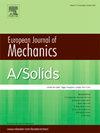Mitigation of vertical vibrations in coupled meta-rods through internal interactions and boundary constraint
IF 4.2
2区 工程技术
Q1 MECHANICS
引用次数: 0
Abstract
Environmental vibrations caused by seismic waves and traffic loads pose increasing risks in urban areas due to their low attenuation and structural impact. To mitigate the in-plane bulk waves and vertical Raleigh wave component generated by ambient vibrations, we proposed a coupled meta-rod assembled from a local resonance (LR) bar and a negative-stiffness (NS) system. This meta-rod is designed in two forms to redistribute the wave energy, where the NS system is introduced as a boundary constraint. We develop analytical models based on the Bloch conditions and the transfer matrix method to solve and investigate dispersion relationship and transmission abilities. Complementarily, finite elements (FE) models are also established to validate the analytical results and further visualise the interaction between the LR bar and NS system during longitudinal wave propagation. The results indicate that most of long-wavelength waves propagate through the low-stiffness medium within the coupled system. As wave energy is redistributed across frequency, an additional attenuation region emerges beyond the LR bandgap due to the maximum in-phase motion between the LR bar and NS system. This internal interaction gradually dominates the attenuation mechanism as the LR bandgap shifts toward lower frequencies under boundary constraints, providing more effective suppression before the resonance frequency. This study offers a promising strategy for the design of efficient vertical vibration mitigation solutions.
通过内部相互作用和边界约束减轻耦合棒的垂直振动
地震波和交通荷载引起的环境振动由于其低衰减和结构影响,对城市地区构成越来越大的风险。为了减轻环境振动产生的面内体波和垂直罗利波分量,我们提出了由局部共振(LR)杆和负刚度(NS)系统组合而成的耦合元杆。在引入NS系统作为边界约束的情况下,设计了两种形式的元杆来重新分配波能。我们建立了基于布洛赫条件和传递矩阵法的解析模型来求解和研究色散关系和传输能力。此外,还建立了有限元模型来验证分析结果,并进一步可视化了纵波传播过程中LR杆与NS系统之间的相互作用。结果表明,在耦合系统中,大部分长波在低刚度介质中传播。由于波能跨频率重新分配,由于LR棒和NS系统之间的最大同相运动,在LR带隙之外出现了额外的衰减区域。随着LR带隙在边界约束下向低频移动,这种内部相互作用逐渐主导衰减机制,在共振频率之前提供更有效的抑制。该研究为设计有效的垂直振动缓解方案提供了一个有前途的策略。
本文章由计算机程序翻译,如有差异,请以英文原文为准。
求助全文
约1分钟内获得全文
求助全文
来源期刊
CiteScore
7.00
自引率
7.30%
发文量
275
审稿时长
48 days
期刊介绍:
The European Journal of Mechanics endash; A/Solids continues to publish articles in English in all areas of Solid Mechanics from the physical and mathematical basis to materials engineering, technological applications and methods of modern computational mechanics, both pure and applied research.

 求助内容:
求助内容: 应助结果提醒方式:
应助结果提醒方式:


